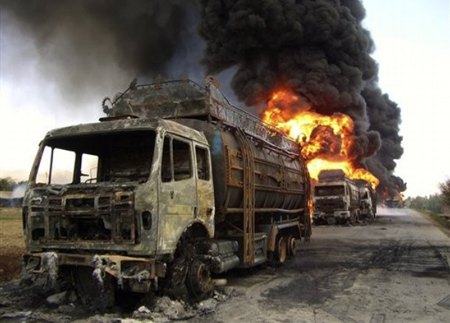
Taliban Could Defeat NATO in 30 Days
Logistics is the Achilles heel of Western forces
Reading time: (Number of words: )
Taliban leader Mullah Omar’s announcement on September 8, 2010, that the Taliban was close to victory against NATO should not be dismissed. The Taliban have the military capacity to shut down the NATO supply links to Pakistan and other adjoining countries. NATO and American forces have such exorbitant daily supply needs that the Taliban could force some or potentially most Western forces to retreat from Afghanistan within 30 days.
Western military supplies (other than ammunition, weapons, communications gear and some spare parts, which apparently are all air-lifted) filter into Afghanistan through a small number of mountain passes and then are internally redistributed through a poorly constructed and insecure “ring road” system. On June 20, 2009, Major-General Michael Tucker, the Deputy Chief of Staff for Operations of ISAF in Kabul, told Philip Smucker of the Asia Times (for his story Afghanistan’s Road to Somewhere), that:
“Security in Afghanistan is ultimately defined by our ability to build and defend the ring road.”
He was correct and the Taliban know it. As seen in the daily military incident reports, the Taliban have spent years practicing and perfecting their road interdiction tactics. NATO and American forces do not possess the manpower to patrol 3,000+ kilometers of primary roads. In contrast, the Taliban possess the capacity to cut, block and disrupt this road system. The bridges, overpasses, tunnels and passes are especially vulnerable to sabotage during the winter months.
In 1761, the “father” of Afghanistan, the great Pashtun leader Ahmed Khan Abdali/Ahmed Shah Durrani defeated the Maratha army at Panipat, in Haryana State, about 120 kilometers north of New Delhi. He succeeded for two reasons. First, he was able to bring together a number of disaffected groups (Pashtuns, Balochi, Sindhi, Jats and Rajputs), which is exactly what the Taliban is doing. Second, he understood that he could not launch a conventional attack on fortified Maratha positions. The Maratha army was armed with French heavy rifled artillery and all the other components and equipment of a modern 18th century army. It was a heavy, road-bound force. The Pashtun forces, on the other hand, were mainly light cavalry. Ahmed Shah Durrani decided on a siege strategy and was successful in cutting the Maratha supply lines for two months. In January 1761, the Maratha had had enough and left their fortified bases only to suffer defeat at the hands of the Pashtun and their allies. This battle, and its tactics and strategy are well known to Taliban leaders. It may be the model for their future efforts.
The paradox for NATO and the Americans is that in September, 2010, they will have deployed the largest number of troops they ever had in Afghanistan, and yet that is when they are the most vulnerable, as the supply needs for this huge force are potentially crippling.
Western armies have logistics systems which are excessively and unnecessarily complex. American forces alone reportedly require a million gallons of fuel per day and all of it has to be trucked into Afghanistan. Consider this comparison:
1942: A German Panzer Division needed from 30-70 tons of supplies per day.
1968: A North Vietnamese Army Division needed less than 10 tons of supplies per day.
2010: An American Army Division needs in excess of 3,000 tons of supplies per day.
Western bases have all the comforts of home, including gyms and restaurants, and an army of contractors to serve all the needs of the troops. The Western way of war is expensive, wasteful and inefficient.
General David Patraeus needs to act immediately and decisively to reduce his vulnerabilities. He needs to take revolutionary steps to reduce the logistics needs of NATO and American forces. This includes eliminating all private contractors, and removing equipment and troops that are duplicative and unnecessary. The military needs to be relatively self-sufficient. He needs to have contingency plans which will permit Western forces to operate for up to 90 days based on only air resupply.
Finally, General Patraeus needs to consider a new deployment strategy for his surged forces by reducing his footprint in Afghanistan during the winter months. 30,000+ troops should be withdrawn by November and returned to Afghanistan in late spring to deal with any new Taliban offensive. There is no reason to winter-over all of these forces.
Sadly the Pentagon and NATO will do none of these things. If and when the Taliban elect to strike, Western politicians and military officials will claim that they could not have anticipated such a military tactic as cutting off supply routes, even though the Viet Minh used this tactic very effectively at Dien Bien Phu. There will be excuses and finger-pointing and inevitably a scapegoat chosen. The West has adopted a “prayer strategy” for Afghanistan; officials are praying that their supply lines will not be cut. That is a recipe for disaster.











